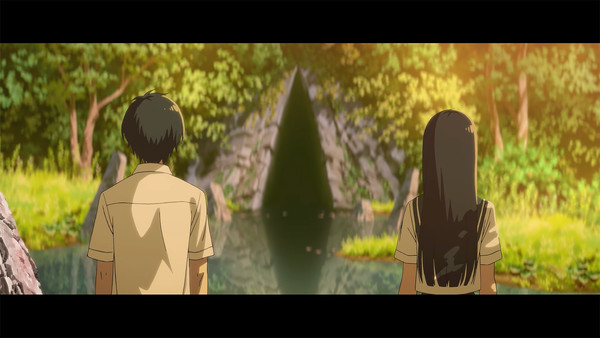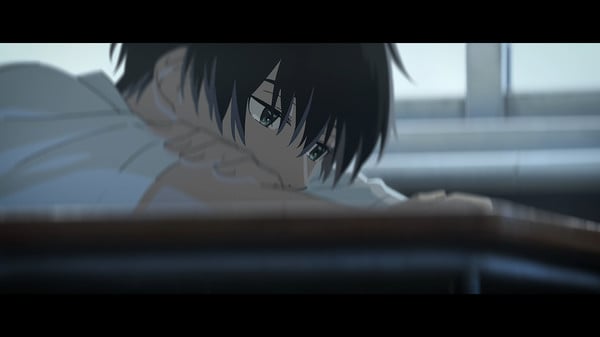Curated From www.animenewsnetwork.com Check Them Out For More Content.

© 2022 八目迷・小学館/映画『夏へのトンネル、さよならの出口』製作委員会
The Tunnel to Summer, the Exit of Goodbyes is a wistful new time-travel high school romance film that touches on many issues that affect young people, like grief, the fear of getting older, and navigating parental expectations. Based on a novel by Mei Hachimoku, it has an all-star team behind it, including director and scriptwriter Tomohisa Taguchi (Akudama Drive) and composer Harumi Fuuki (Deer King). ANN got to sit with Fuuki and Hachimoku, as well as setting producer Shingou Nishikawa and producer Naoki Koyama for an exclusive interview at Otakon on Saturday, after which immediately followed a press conference where they talked about the process of making the film and the inspiration for its story.
Why don’t we start with the tunnel itself? It seems to represent how a person can be stuck in the past or the future and how that can make them lose out on the present. But that’s only my interpretation. I want to know what inspired this tunnel image and what it symbolizes to you.
Mei Hachimoku: So, there’s actually a lot of meanings but the main meaning to me is when I was working on this, there were a lot of uncertainties. And I was feeling the sort of fear and sadness of aging, and you know, time progressing quicker and quicker. So it just represents for me the fear of time passing. And also, there’s this meaning of it being like a portal to a different world or dimension.
In the press conference later that day, Hachimoku expanded on this and stated, “I had lots of interest in time travel-based stories such as The Butterfly Effect and Steins;Gate, which I’m sure everyone would know. Those tended to be my favorite ones because they had an emotional effect. And from that moment on, I thought that I wanted to do something with regards to time and build time into the story. Also, I think that these interests kind of coincide with the anxieties I was feeling about the future.”
A good portion of the novel was about the relationships between young girls, with Anzu and Koharu starting as a bully and her victim and eventually becoming close friends when Anzu fights back. Who or what inspired these female characters and their relationship?
HACHIMOKU: The idea behind it was that Anzu is very unique, and she’s dropped into this school environment. And then I just wanted to illustrate how the people and surroundings might be affected by her, her dropping in and them interacting with each other.
Anzu is an artist frustrated with her parents, who are trying to prevent her from making art. Some people might even describe them as abusive. What are you trying to say with the film about the experiences of young artists and their families?
HACHIMOKU: I think that every family has these sorts of flaws. So I also wanted to illustrate that, but in the relationship between the parents and Anzu, it’s just a part of it. And I wanted to illustrate the relationship between siblings and how that plays out.

© 2022 八目迷・小学館/映画『夏へのトンネル、さよならの出口』製作委員会
What were you trying to represent about siblings? What drew you to the sibling relationships?
HACHIMOKU: So personally, I believe that compared to an older brother and little brother relationship, there’s a tighter bond in a brother and a little sister relationship. So personally, that’s a more significant relationship, and I wanted to illustrate that.
Hachimoku elaborated on the grief that Kaoru feels about his little sister’s death at the press conference. He described that everyone has a bit of grief with them.
“It’s a natural human condition,” he said. “However, if one is able to return to the past, I guess what they might want to do is erase that grief.” When it came time to write Tunnel to Summer, Hachimoku considered what would make a better story. “So I thought that, rather than erasing [grief], we want to see what characters do in respect to the amplified effects of that grief.”
“I believe everyone is faced with the difficult decision of staring grief itself in the eye.”
Tunnel to Summer has a quite varied score with influences from funk to jazz to somewhat ritualistic music. How did you decide what style to use in each scene? What drew you to this kind of eclectic approach?
Harumi Fuuki: For everyday life, I decided to use more of a classical approach with piano, like relatable everyday instruments, and to represent all social interactions and emotions, I used a Spanish guitar. But for the scene where [the characters] go into the tunnel, I wanted to capture the mysterious atmosphere, so I used gamelan music to represent that.
Silence was also important to Fuuki in her compositions for the film, adding music in emotional scenes but also utilizing quietness when appropriate.

© 2022 八目迷・小学館/映画『夏へのトンネル、さよならの出口』製作委員会
“Just because the scenes is quiet doesn’t mean that there was no music, because to me silence itself is music. So seeing the whole movie as a piece of music, you have these silences and rests within it. And then after the rests, you have music,” Fuuki said.
The tunnel scene has a very complex rhythmic quality. There’s no strict meter in gamelan music, right? How did you take that influence and use it in that scene?
FUUKI: So, the music director [Satoki] Iida-san said I should use gamelan music for this scene. And I agreed with him. Inside the tunnels, the dimensions are sort of twisted and flexing around. To represent that, the rhythms are staggered, and there are some irregular beats added inside the measure.
What drew you and the team to this novel to adapt, and what made Tomohisa Taguchi the right choice for director? His work in Akudama Drive is a very different subject matter and genre from Tunnel to Summer.
Naoki Koyama: As for Taguchi, the people from [animation studio] CLAP, I think, referred us to him. So I thought that would be the right decision. And I felt like the theme of this story was talking about obscured feelings and then feeling emotions that are sort of pushed aside and hidden. By turning this light novel into a movie, I could inspire people and try to help those who have pushed aside their emotions deep down.
Koyama shared at the press conference that he hopes the audience relates to Anzu and Kaoru and gets to know them as human beings.
“They might be slightly unique characters and maybe a bit dramatic. However, I feel that if you can feel that they are human and if you can feel compassion for them, that is the goal.”
The Tunnel to Summer, Exit to Goodbyes film opened in Japan in September 2022, and the English-subtitled version premiered at Otakon in July. HIDIVE will release the film in theaters in the U.S. on November 3.
